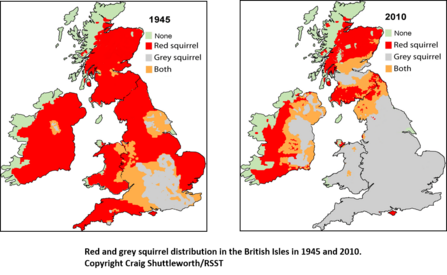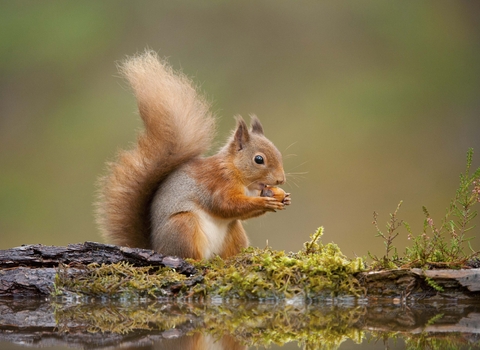Squirrels in the UK
There are two species of squirrel in the UK; red squirrels and grey squirrels. Red squirrels are our native species and have lived in the UK for around 10,000 years, Grey squirrels were introduced to the UK from North America by the Victorians in the 1800s, the first record of them escaping and establishing a wild population is 1876.
Why do red squirrels need protecting?
Grey squirrels are a familiar sight for many people across large parts of the UK and are often seen in parks and gardens, whilst the range of our native red squirrels is now limited to certain areas of the UK, such as Anglesey, parts of northern England and Scotland. In many cases they have retreated to wilder, remote locations. Unfortunately, without conservation management, red squirrels could become extinct in England in approximately 10 years. Time is really running out to save our red squirrels.
To preserve red squirrels, they must be kept apart from grey squirrels as the two species cannot live together long term. The map below illustrates this as it shows that grey squirrels have replaced red squirrels across almost all of England and Wales.

Red and grey squirrels distribution in the British Isles in 1945 and 2010. © Craig Shuttleworth/RSST
How are The Wildlife Trusts helping?
The Wildlife Trusts has been at the forefront of efforts to save red squirrels for decades; undertaking habitat management to help red squirrels, education and awareness projects, monitoring of squirrel populations and targeted control of grey squirrels in areas where red squirrels are at risk of extinction.
The Wildlife Trusts was part of Red Squirrels United, a partnership of academics, practitioners and volunteers, working together on a programme of red squirrel conservation. It launched in 2015 and was focused on conserving red squirrel populations in nine specific areas in Northern Ireland, Northern England and Wales (see map below).
Local red squirrel conservation projects are also taking place with Dorset Wildlife Trust, Hampshire and Isle of Wight Wildlife Trust, The Wildlife Trust of South and West Wales and Scottish Wildlife Trust.

Frequently asked questions
Can red squirrels and grey squirrels live together?
Unfortunately not. Grey squirrels compete more successfully than red squirrels for food and habitat. They are larger and more robust, and can digest seeds with high tannin content, such as acorns, more efficiently. This forces red squirrels into other areas where they can find it more difficult to survive.
Grey squirrels also transmit a squirrelpox virus which can normally kill red squirrels. Once infected, red squirrels often die of starvation or dehydration.
What are the main threats to red squirrels?
The grey squirrel is the main reason for the decline of the red squirrel. Habitat loss has also contributed to the red squirrel’s decline. This occurs when areas of woodland are destroyed or become separated by development and changing land-use. This leads to isolated areas which cannot sustain viable populations of wildlife, including red squirrels in some places. Squirrelpox virus is fatal to red squirrels but is carried by grey squirrels without causing them any harm.
What is squirrelpox and what can be done about it?
This virus, carried by grey squirrels without causing them harm, is fatal to red squirrels and once infected red squirrels often suffer a slow and painful death. The virus produces scabs and sores in and around the eyes, nose, mouth, feet, ears and genitalia. The infected squirrel is very quickly unable to see or to feed properly and rapidly becomes dehydrated and malnourished.
A vaccine against squirrelpox is in development but it could be many years before this is available in the affordable and easily dispensable form necessary to assist red squirrel conservation. Targeted and co-ordinated grey squirrel control to keep densities of grey squirrel very low in carefully chosen areas is used to combat the spread of disease.
Where in the UK does this project work?
This project is about maintaining the remaining red squirrels we have in parts of Northern Ireland and Wales and some parts of the north of England and expanding them in a few places in these areas to give some of the more isolated populations a better chance of survival.
The map above shows the project areas where Red Squirrels United is working (a separate project is carrying out similar work in Scotland).
Conservation management is targeted only to red squirrel stronghold areas and enables red squirrels to exist in these areas. This project is not working in the remainder of the UK which is still home to grey squirrels. Ultimately it means that both red and grey squirrels continue to exist in the UK although they must be kept apart as the two species cannot live together in the long-term, primarily because grey squirrels carry the squirrel-pox virus which kills red squirrels.
What scientific evidence is there?
Natural England is the the government's adviser for nature conservation in England. It's 'Review of red squirrel conservation activity in northern England (2009)' is the most comprehensive review of the science to date.
Other reading:
Conservation Plan for Red Squirrel Conservation (2009)
Scottish Strategy for Red Squirrel Conservation (2015)
Red Squirrel Conservation Action Plan (1999)
What happens if grey squirrels are not managed in places where they interact with red squirrels?
As the historic loss of red squirrels from much of Ireland, England, and Wales shows, non-intervention would lead to further loss of red squirrels ultimately ending in their extinction on the UK mainland. Evidence shows that without conservation management red squirrels are at risk of becoming extinct in England and Scotland (1).
Do pine martens help control grey squirrels?
Research by NUI Galway has shown that a high-density of Irish pine marten populations is causing corresponding populations of grey squirrels to collapse, with a recovery of red squirrels following. A new project has been launched by the University of Aberdeen to investigate whether the same effect is occurring in Scotland in areas where the pine marten is recovering, where differences in ecological conditions may make the outcome different to that in Ireland. The project will run until the end of 2017 and is led by Dr Emma Sheehy and Professor Xavier Lambin. This area of research is of interest but at the moment the fledgling recovery of the pine marten cannot be sole prospect for survival of our red squirrel due to its relatively low population densities.
The Wildlife Trusts worked with the following organisations to form Red Squirrels United: Newcastle University, Forest Research, The Wildlife Trust for Lancashire, Manchester and North Merseyside, Red Squirrels Trust Wales, Northumberland Wildlife Trust, Ulster Wildlife and The Wildlife Trust of South and West Wales.
Find out more about Red Squirrels United.





